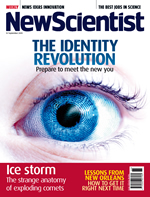Nano-material is harder than diamonds
- 18:18 30 August 2005
- NewScientist.com news service
- Will Knight
Related Articles
- Y-shaped nanotubes are ready-made transistors
- 15 August 2005
- World’s smallest toothbrush scrubs capillaries clean
- 12 June 2005
- Carbon nanotubes used in computer and TV screens
- 21 May 2005
- Search New Scientist
- Contact us
Web Links
A material that is harder than diamond has been created in the lab, by packing together tiny "nanorods" of carbon.
The new material, known as aggregated carbon nanorods (ACNR), was created by compressing and heating super-strong carbon molecules called buckyballs or carbon-60. These molecules consist of 60 atoms that interlock in hexagonal or pentagonal shapes and resemble tiny soccer balls.
The super-tough ACNR was created by compressing carbon-60 to 200 times normal atmospheric pressure, while simultaneously heating it to 2226°C.
The properties of the resulting material were then measured using a diamond anvil cell at the European Synchrotron Radiation Facility in France. This instrument squeezes a material between two normal diamonds, enabling researchers to study it at high pressure using synchrotron radiation – extremely intense X-rays which reveal the material’s structure.
The researchers found their ACNR to be 0.3% denser than ordinary diamond and more resistant to pressure than any other known material.
Industrial applications
"Our material actually scratches normal diamonds," says Natalia Dubrovinskaia, of the University of Bayreuth, in Germany, who led the research. "We were very excited, and glad."
While an ordinary diamond gets its hardness from the strong molecular bonds between each of its atoms, ACNR derives its strength from the fact that it is formed from interlocking nanorods, the researchers say.
Dubrovinskaia told New Scientist the material could have a wide range of potential industrial applications. As it is stable at very high temperatures, she says it could be better than normal diamond for deep drilling and polishing abrasive materials. She also believes it will be easy to mass produce the super-tough material. "It's a very reproducible result," she adds.
Journal reference: Applied Physics Letters (vol 87, 08, p 3106)










